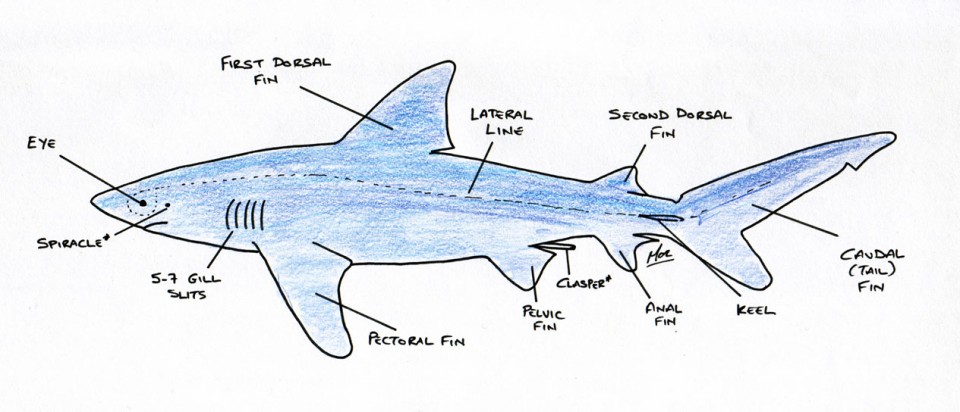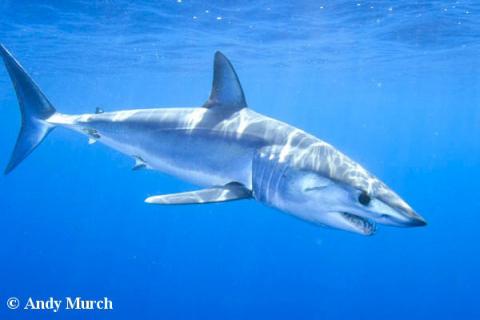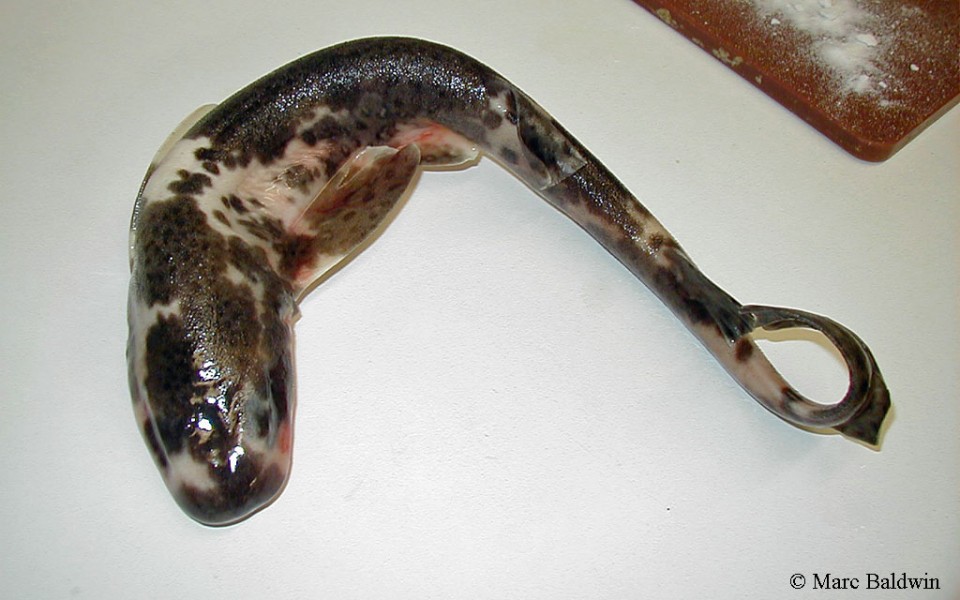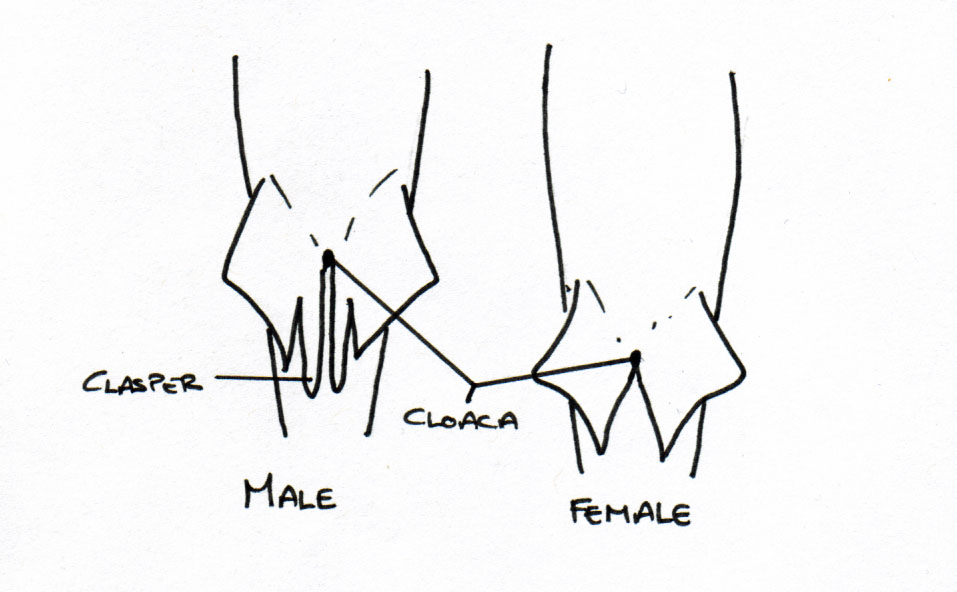Elasmobranch Appearance
Appearance
Sharks have an unmistakable fusiform (bullet-shaped) body form, with eight fins attached: two dorsal (back) fins; two pectoral (side) fins; two pelvic fins (underneath towards the tail); a single anal fin (underneath, just in front of the tail); and a caudal (tail) fin. The dorsal and anal fins prevent the shark from yawing (i.e. moving side-to-side about its vertical axis), while the pectoral and pelvic fins guard against rolling and pitching (i.e. head up and tail down, then v/v cyclically). The caudal fin provides the primary propulsive force, although it is also associated with lift in some species. There are two types of caudal fin observed in sharks: heterocercal, where the top lobe is larger than the bottom; and homocercal, where lobes are symmetrical. The sharks with homocercal tails tend to be the large, fast swimming species including the great white, shortfin mako (Isurus oxyrinchus) and porbeagle (Lamna nasus). Heterocercal tails tend to be associated more with bottom-dwelling species, although they are also a trait of the carcharhinoid (whaler and reef) sharks.

The caudal fin of most extant batoid species has been demoted to almost vestigial status, with most skates and rays swimming via undulatory movements of their expanded, wing-like pectoral fins.
When asked to picture the world's fastest animal, I suspect most think of the cheetah (Acinonyx jubatus); but actually that title belongs to a fish. Cheetah can attain a top speed of 60mph (100kph) over short (less than 550m, or about a third of a mile) distances on level ground, but in speed trials off Florida, a sailfish (Istiophorus platypterus) took 91m (almost 300ft) of line in three seconds, equivalent to a swimming velocity of 68mph (109kph).
Precisely how fast elasmobranchs can swim has been a topic of debate in the popular literature for many years. The purposed top speed of the shortfin mako shark has been variously reported as 22 to 55mph (35-88kph). Indeed, in his 1984 (and subsequently 2001 revision) catalogue of extant shark species, Leonard Compagno described Isurus oxyrinchus as "the peregrine falcon of the shark world". Similarly, according to ReefQuest Director and shark biologist R. Aidan Marin, a relative of Isurus, the great white shark, packs a considerable amount of propulsive power, attaining estimated speeds of 30mph (48kph).

Rapid bursts of speed by these predatory sharks draw on white muscle mass, so-called because the lack of blood vessels makes the muscle appear white, that burn carbohydrate in the absence of oxygen. The lack of oxygen means that the carbohydrate oxidation is incomplete and glucose is oxidised to produce lactic acid. When the lactic acid reaches a threshold, it must be detoxified (which requires oxygen) and the intense activity of the white muscle stops. (In humans, this build-up of lactic acid causes a "stitch".) Thus, these intense bursts of speed cannot be maintained for prolonged periods of time. For most of the time, elasmobranchs and other fish rely on red muscle masses for normal cruising speeds (typically between 0.2 and one metre per second / 0.5-3 ft. depending on species) and use white muscle only during hunting or predator escape manoeuvring.
Colour
Sharks can range in colour from grey through most shades of blue and even into yellows and pinks. The UK shark fauna also vary in colour. The basking shark, along with many of the catsharks, tend to be brown, with white or black markings. At the other end of the scale are the shortfin mako and the aptly-named blue shark (Prionace glauca), which are usually a striking cobalt blue colour with a white belly.
One distinctive feature of shark colouration is that the dorsal (back) surface is always darker than the ventral (underside) surface. A dark dorsum helps the shark to blend into the seabed when viewed from above, while a white dorsum blends the shark with the bright, sunlit, surface. The point of all this is to make the shark more cryptic, and thus less obvious to potential prey or a predator. Hence, White sharks have a dark grey back and bright white ventrum (the boundary between the two is referred to as a "line of demarcation") and are, therefore, rarely seen hunting over sandy bottoms where a dark shape would be easily detected against the light sand.

Rays, too, have a broad colour range, although most of the species seen around the UK coast tend to be a sandy brown colour, with darker brown or black markings. The smalleye (or painted) ray is an exception to this, being almost pale pink with white spots and a red rostrum (nose). The undulate ray is a muddy-brown colour with dark green-brown lines and spots.
Sexing
Sexing sharks is a relatively simple task. Male sharks have elongated edges to their pelvic fins that roll up forming sausage-like protrusions called claspers -- or more accurately, myxopterygia (pronounced: mix-op-ter-ridge-ee-a) as they are not actually used for "clasping" the female -- the front opening of which is the apopyle and the rear opening (as it is a tube) the rhipidion.

The claspers are "intromittent organs" that are used to transfer sperm from the male's ductus deferens to the female's uterus. Some species have small hooks and a spur on the clasper to keep it in place during sperm transfer. Female elasmobranchs don't have claspers, only the opening into which the clasper fits and the waste products exit, called the cloaca (pronounced clow-ache-kah). Females generally grow to larger sizes than males of the same species and some species exhibit sexual segregation for much of the year.